CC FAQ Pages
Other Resources
Housing FAQ
How do I house ___________?
Start by visiting the Species Database section of this site. Make sure to base the habitat on the needs of the animal, not your convenience. For examples and photos of setups, see Setting it Up.
What do I need to properly house an aquatic newt?
- Good water quality. This is the most important task in keeping healthy newts. For details, read the Water Quality FAQs. Adult newts of fully aquatic species usually live in water that is 6-12 inches deep.
- Tank. We recommend 10 gallons minimum. In a smaller tank, you will have difficulty getting the kind of stable water chemistry that will keep your newts healthy long-term.
- Secure lid. Important! Many newts are excellent climbers, and escape is usually fatal. Some can even climb across the underside of horizontal surfaces. Even large, fully-aquatic newts have been known to climb out of their tanks. There must be NO cracks or openings of any kind. Really! Use electrical tape or foam pads to seal any openings, no matter how small. See our article, Preventing Escape. A screen top is better for cooling, but a hood top is also fine. Solid glass lids do not allow sufficient ventilation and should only be used if the setup includes an air pump.
- Filter. Several kinds of filters work well in a newt tank. Power filters that hang on the tank are not recommended because they leave large gaps that a newt can escape through. For detailed information see the article Aquarium Filters for Caudates.
- Gravel (optional). Newts can live quite well without it, but if you want it, choose either sand, or a kind with large pieces that cannot be swallowed. Don't use a thick layer, because the gravel deep at the bottom will get no oxygen and will tend to foul the water. If you buy gravel that is a natural color, you won't have to waste time scrubbing it clean. However, you will need to clean loose debris out of it often, regardless of color.
- Island. Can be made of rocks, bricks, flower pots, Legos, a floating plastic lily pad, cork bark, or any combination. It is better not to make the land area out of a thick layer of gravel, as explained above.
- Siphon and turkey baster. See "cleanup" question below.
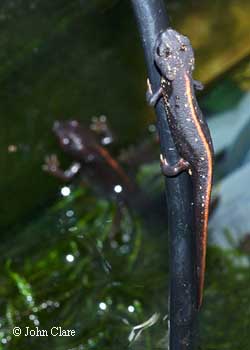
|
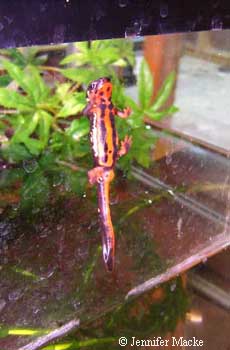
|
| Warning! Nearly all newts and salamanders can climb, including straight up glass. Prevent a tragedy! Read Preventing Escape. | |
What do I need to properly house a terrestrial salamander?
- Container. This can be an aquarium, or a plastic tub with holes.
- Secure lid. A screen top is a little better for cooling, but a hood top is also fine. Some salamanders are able to climb glass, so don't take any chances with escape. See our article, Preventing Escape.
- Small water dish. Keep in mind that some salamanders are poor swimmers and can drown easily. Also, anecdotal evidence suggests that salamanders are more likely to become ill if kept in a semi-aquatic habitat.
- Substrate. We recommend top soil and/or shredded bark. Avoid acidic substrates such as peat moss. Coconut fiber ("Bed-a-beast" bricks) provides excellent moisture retention, but poor biological breakdown of wastes; it is best when mixed or topped with soil. If your salamander is species that likes to dig, provide deep enough substrate for digging. Remember that the substrate needs to stay moist but not soggy. Wet gravel is a poor substrate because it fouls easily and, for larger sals, poses a swallowing hazard. See Terrestrial Substrates article.
- A hiding place. This reduces animal stress and is very important for most species. Good hiding places include bark, cork bark, rocks with dug-out space under them, dry tree leaves, upturned flower pots, etc. Although hides will decrease the visibility of the animal, they will increase the animal's comfort immensely. If several animals are kept together, provide at least one separate hiding place per animal.
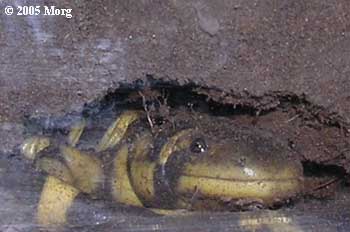
Many terrestrial species are best kept with a substrate they can dig.
How can I keep my newt/salamander cool enough during the summer?
There are many ways to lower the temperature of your tank. We have an entire article devoted to this subject. See: Aquarium Cooling Methods.
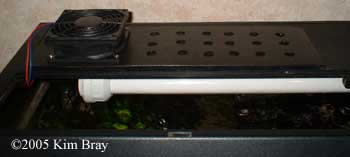
It can be challenging to keep newts and salamanders cool enough during the summer. For an aquatic tank, increasing evaporation will decrease water temperature below that of the room air. In this example, a small computer fan was mounted over an aquarium to increase evaporation. For more examples, see Aquarium Cooling Methods.
How do I clean up my aquatic newt's tank?
Most importantly, remove any uneaten non-live food immediately after feeding. A turkey baster works well for this. Change about 1/4 of the water every 2 to 3 weeks, replacing it with de-chlorinated water. To clean out debris from among the rocks, buy a siphon with a gravel-cleaning attachment. For more details on water changes, see the Water Quality FAQs.
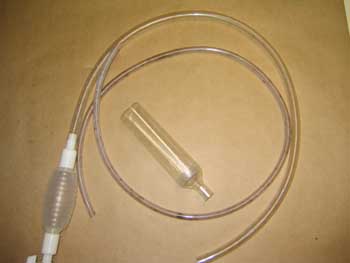
|
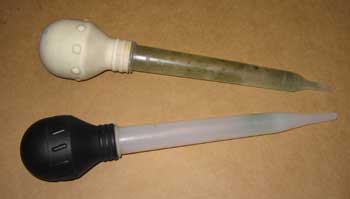
|
| LEFT: siphons are used for "major" cleaning of aquariums. A siphon can be just a simple piece of tubing, or can include a gravel washing attachment (center) or bulb to help start the flow of water (lower left). ABOVE: a turkey baster is useful for quick clean-ups. | |
Does my animal need a heater, heat lamp, or hot rock?
Probably not. Most salamanders and newts do best at temperatures below 21°C (72°F). There are a few exceptions, but for common pet species, you are more likely to need a chiller than a heater. If you aren't sure, see the caresheets in the Species Database.
Does a salamander/newt need full-spectrum or UV lighting?
Probably not. Some salamanders require certain light cycles to trigger breeding, and the wavelengths of light required are unknown. Amphibians are able to utilize UV light in the synthesis of vitamin D. However, if given a diet with sufficient vitamins, ordinary room light is adequate for health.
I have algae in my tank. What should I do?
See: Aquarium Invaders: Algae, Snails, Worms, and Other Critters.
I have snails/tiny worms/tiny swimmy things in my tank. What should I do?
See: Aquarium Invaders: Algae, Snails, Worms, and Other Critters.
Can I house _______ with ________?
Probably not. Mixing species has never been a wonderful idea. For real-life examples of what happens when you try to mix amphibian species with other amphibians or with fish, etc., see Species Mixing Disasters in the Articles section.
Can a newt live together with a fire-bellied toad, dwarf frog, or clawed frog?
No. These frogs not only like warmer water than a newt does, but they also try to eat anything. Firebellied toads have a very large mouth and can injure or kill a newt. A clawed frog will get so big that it could easily eat a newt. A dwarf frog could never eat a newt, but it could quickly drive it nuts by constantly nipping at the newt's limbs. Also, the newts may stress a dwarf frog to death. For examples learned the hard way, see Species Mixing Disasters.
Can a newt live with a small turtle?
No. Even small turtles can nip off a newt's leg or tail. Also, turtles secrete (and tolerate) much higher amounts of ammonia than newts.
What type of fish can live with my newt?
Most fish in pet shops can NOT live with newts because they need much warmer temperatures than newts do. Tropical fish can't take the cold temperature that is so healthy for most species of newt. Listed below are a few fish and other animals that might be OK. However, watch for any signs of stress to the newts, and note that a few newt species are able to catch and eat fish, snails, or shrimp. For examples of what might go wrong, see Species Mixing Disasters.
- White Cloud Minnows
- Guppies**
- Zebra, Gold, and Blue Danios**
- Scissor-tail Rasbora**
- Ram's Horn Snails
- Freshwater shrimp
- **These fish species are suitable only if you have a species of newt that will do well above 68°F (20°C) year-round. This is pushing the lower limit of tolerance for these fish, and pushing the upper limit of wintertime temperature for most newts.
 Ghost shrimp tolerate cool-temperature aquariums and are peaceful tankmates for newts. However, newts may sometimes eat them. |
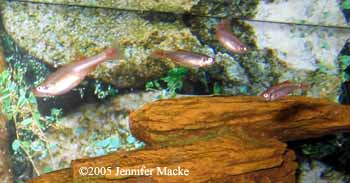 White cloud minnows are colorful, peaceful fish that tolerate cool temperatures. |
How about goldfish with newts/axolotls/mudpuppies/waterdogs?
Not a good idea. Goldfish do tolerate cold temperatures, but they grow very large. Also, goldfish secrete relatively large amounts of ammonia, which is poorly tolerated by amphibians. In the case of amphibians with gills, goldfish are likely to irritate them by pecking at the gills.
Can I house newts or salamanders in my indoor/outdoor pond?
Unlike fish, newts and salamanders can (and will) walk out of a pond. There are two cases where newts/sals might be a good idea in a pond. (1) Fully aquatic species, such as axolotls or mudpuppies, can be kept very well in indoor or enclosed ponds. In outdoor ponds they are subject to predators and parasites and are difficult to monitor, so this is not recommended. (2) If there is a newt/sal species that is NATIVE to your area, you can establish a population in your pond by raising some local eggs/larvae in your pond. The adults are likely to leave, but may return in future years to reproduce.
If the animal you added to your outdoor pond is non-native and escapes, you not only may have killed the newt, but you have also broken the law. It is illegal to release non-native species because of the risk of spreading disease and altering ecosystems.
Can I keep a tiger salamander in a semi-aquatic setup? It seems to like to swim.
Tiger salamanders sometimes seem to "like" swimming. However, this is not a natural behavior, and may be caused by a lack of suitable digging substrate or hiding places in the land portion of the tank. You would never find an adult tiger salamander swimming in the wild, except during breeding. Anecdotal evidence suggests that tiger salamanders kept in semi-aquatic setups are more prone to disease in the long run.

